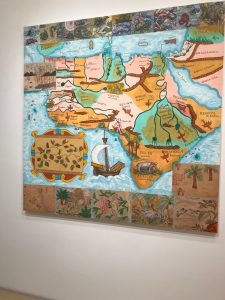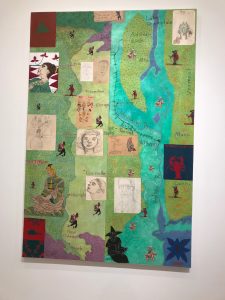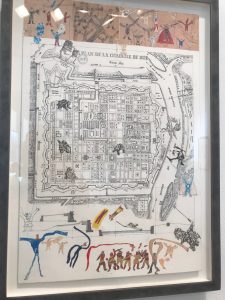Last week, I had the pleasure of going to Joyce Kozloff’s exhibit, Girlhood, in New York City’s Chelsea neighborhood. Girlhood was featured at the DC Moore Gallery from October 5 to November 4. It was an interesting, eclectic collection that I really enjoyed.

Photo taken by Sage Daugherty. This piece in particular was one of my favorites — the colors just drew me in.
The mixed media exhibition stems from folders of carefully preserved grade school art, which the artist found while cleaning out her parents’ house after they passed away. The childhood drawings were then carefully arranged with the artist’s meticulously painted maps, charts, infographics and other geographical knowledge.
In a DC Moore Gallery press release, Kozloff discussed her exhibition: “The worldview of my naïve public-school pictures is further away from me today than the places were then. And that’s why my conventional grammar school innocence feels weirdly relevant to me – within our polarized society, where so many people hold onto fantasies about recovering an imaginary past.”
In an interview that was part of the exhibition, she said that the maps she had drawn between the ages of nine and eleven were for her social studies classes. A quote in an essay in the catalogue struck me particularly: “As children we are often innocent and accepting, until we learn to be critical, to perceive the spectrum of truths and untruths.” I read the catalogue after I’d gone around the gallery a few times, and that one line just stuck in my brain. I found myself reminiscing about my childhood, and actively wishing to “grow back down,” as it were. Or at the very least, I wish I could have kept some of the childhood innocence depicted in the Girlhood exhibition; it seems like the more removed from childhood I get (I’m in my early twenties) I get more and more cynical and jaded about the world and life in general.

Photo taken by Sage Daugherty. This piece included some of her childhood maps, some adulthood recreations and my personal favorite — depictions of book covers that both the artist and I read as children.
My favorite pieces in the exhibition were ones where I could recognize certain things I had studied in school as a child, or favorite childhood books of mine. I really liked that each of the pieces featured in Girlhood had so many parts and layers, and sometimes it was hard to know what part of the artwork to focus on first. There was one piece in particular that I was looking at rather intently, and then it clicked. At first my eyes were drawn to a map of New York State, overlapped with a map of Illinois and Tennessee and a bunch of other states, and then I moved onto looking at the various cut outs and art pieces that were placed over the maps. My favorite parts of this particular piece were drawings that Kozloff had done as a child of different book covers. I felt a thrill of realization as I recognized the books — The Clue of the Velvet Mask, Little Women, Eight Cousins and Five Little Peppers and How They Grew. I had read and loved them well as a child myself, to the point where one of the copies was literally falling apart.
Also included in the exhibition were fifteen collages from Kozloff’s 2001-2002 series, Boys’ Art, in which she focused on combining her son’s childhood drawings with vintage historical maps. What struck me immediately was the difference in her childhood drawings versus those of her son’s.

Photo taken by Sage Daugherty. A piece from Kozloff’s series, Boys’ Art, which highlights childhood drawings of her son.
Her childhood work was mostly maps, flowers and covers of favorite books she had read, where her son focused more on superheroes and war depictions. I thought it was interesting to see how gender socialization affects children from a very young age, with in this instance, girls drawing flowers and books covers and boys drawing more “masculine,” intense images.
How the world perceives gender impacts us from the moment we are born, with boys stereotypically dressed in blue and girls dressed in pink, for example. The exhibition in particular really made me think about these things, and how perhaps girlhood and girls’ experiences would be different if they lived in a world where they were truly equal to boys, instead of society just paying lip service to the fact but never actually intrinsically recognizing gender equality. I wish this exhibition had more time in the gallery instead of just a month, but I was very glad to have gotten a chance to explore Girlhood. What do you think of Kozloff’s work, and how does it relate to your own girlhood experiences?
-Sage Daugherty
Junior Girl
Girl Museum Inc.
